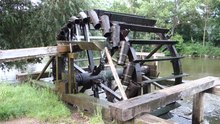Bucket wheel
A bucket wheel is a water wheel that rotates around a horizontal axis. Part of its circumference is immersed in water and is filled with water buckets (also known as "kumps"). These buckets fill with water when they are submerged in the river or in a well. In the area of the highest point of the wheel, the contents of the tubs are then emptied into a collecting basin, from where it flows into an irrigation canal.
Around the Mediterranean Sea as well as in English-speaking countries and in India, a bucket wheel driven by the flow of water is called Noria and one with an external, originally animal drive is called Sakia or Saqiya .
construction


A bucket wheel is usually driven by water power, but can also be set in motion by human, animal, wind or motor power.
The vessels or buckets can be movable; they then hang, for example, on round nails and tilt by touching the edge of the channel with a bracket attached to their side. If the vessels are tight, they must be positioned so that the water flows out automatically in the highest position. This includes the Chinese bucket wheel, whose vessels are made from bamboo cane. Instead of filling the circumference of the wheel with individual vessels, the entire wheel rim is also designed as a cavity, which is divided into cells by partitions parallel to the wheel axis ("cell wheels"). These cells are given the openings required for scooping and pouring on the circumference or to the side. This also includes the “drum wheel” and the “worm wheel”.
The smaller the scoops and the fewer scoops that are attached to the wheel, the greater the difference in height that can be overcome with a given drive force. In this way, with appropriately large wheel diameters, height differences of a few meters can be overcome. If the existing current is not sufficient for the desired pumping capacity, small weirs (“wings”) can be built in the river to strengthen the current , which feed the water to the wheel at the right angle. In the case of the historical water pumps on the slowly flowing Regnitz near Möhrendorf , which are only operated in summer , these weirs - like the wheels themselves - are traditionally rebuilt at the beginning of each summer season.
Water-powered bucket wheels are attached directly to the water wheel with its paddle boards, which is driven by the current. No power transmission via the axle is necessary. Such bucket wheels are naturally operated predominantly in places with a slight gradient, since the water for irrigation could otherwise be drained off at a higher point without a water wheel.
history
Water paddles were already known in ancient times. However, because the constructions had to be repaired or completely renewed again and again, not much is known archaeologically about them - the oldest evidence and texts come from the Fayyum basin in Egypt and date from the 4th to the 2nd century BC. Dated. At about the same is found in India, the Sanskrit -Word araghatta which of the components ara ( "wheel") and ghattam composed ( "pot"). There were probably no single-axis bucket wheels in today's sense, but two wheels connected by ropes with attached clay jugs, whose operation had to be kept going by animals (donkeys, camels, buffalo). It is not known when exactly the first uniaxial bucket wheels appeared.
Examples

The famous norias of Hama in Syria are considered to be the largest in the world. With correspondingly large wheel diameters you overcome height differences of z. T. over 30 meters. The water art of Mértola in Portugal probably had a bucket wheel with a diameter of 24 m. In the fields of the Valle de Ricote in southeastern Spain there are also several large historical bucket wheels.
The Middle Franconian community Möhrendorf an der Regnitz is known for its many water paddle wheels .
A further development of the classic bucket wheel is located on the Hönne river in Menden . Instead of the scooping cups, an independent scooping wheel was combined with a driving waterwheel (here: reverse cell wheel). In contrast to scoops, the wheel has separate inlets (radially arranged slots) and outlets (lateral spouts). The bucket wheel is used to fill a circumferential canal on the Hönneinsel.
See also
Web links
- Article Schöpfrad in Brockhaus' Kleines Konversations-Lexikon, fifth edition, volume 2. Leipzig 1911., p. 652
- Article on Spanish Bucket Wheels (Norias )


